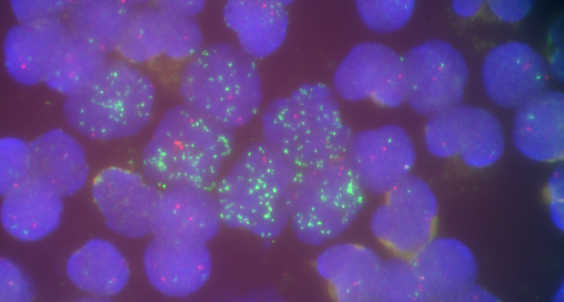Evolution 2.0: What makes cancer more malignant
(Vienna, 23.09.2022) Congratulations! A paper has just been published in the top journal Nature Genetics, with the participation of Dr. Sabine Taschner-Mandl and Dr. Marie Bernkopf from St. Anna CCRI. The authors of this outstanding paper show that random inheritance patterns of cancer genes outside the chromosome, i.e. the scaffold for the genetic information in the cell nucleus, contribute to poor treatment outcomes in patients.
In many tumor types, such as childhood neuroblastoma and glioblastoma, cancer genes, also known as oncogenes, are not only activated or replicated in the chromosomes of the nucleus itself, but also outside as extrachromosomal DNA (ecDNA). This results in aggressive tumor growth, drug resistance and shorter survival. However, the underlying mechanisms of this non-chromosomal transmission of oncogenes during tumor cell division have been poorly understood.

DNA outside the chromosome renders cancer more adaptive
In the present study, the authors mathematically modeled and experimentally investigated how ecDNA is distributed among daughter cells, what impact this has on tumor cell aggressiveness, and the effects of cancer therapy on patient´s ecDNA.
During cell division, the distribution of chromosomes is normally precisely regulated, so that each daughter cell receives an exact gene copy of the mother cell. In extrachromosomal reproduction, DNA segments are randomly distributed among the daughter cells. Thus, one cell may receive only one copy of an oncogene, but another may receive 100 copies. This has a major impact on the adaptability of a tumor. In addition, ecDNAs promote the survival and growth of tumor cells. Under therapy, in turn, ecDNA can be incorporated back into the chromosomes and thus be stabilized again.
“Our contribution to this study was the analysis of extrachromosomal proliferation of the cancer gene MYCN before and after treatment. We studied this in tumor samples from our Neuroblastoma Research and Diagnostics database. In one patient, we showed that cancer therapy increased the evolutionary pressure on the amplified DNA segment of MYCN to the point that it was reintegrated back into the chromosome. Our data served as the basis for the mathematical models used in this publication,” explains Dr. Sabine Taschner-Mandl, head of the Tumor Biology Research Group at St. Anna CCRI, who collaborated on this project with one of the study leaders, Dr. Anton Hensson from Charité Berlin.
Go to publication >> „Lange et al., Nature Genetics 2022“ https://www.nature.com/articles/s41588-022-01177-x